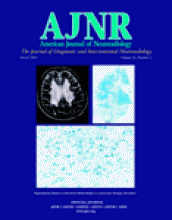Abstract
BACKGROUND AND PURPOSE: Head CT is frequently ordered for trauma patients who are receiving anticoagulation. However, whether patients with a Glasgow Coma Scale (GCS) score of 15 and normal findings on neurologic examination require CT is still debated. The purpose of our study was to assess the use of cranial CT in patients receiving anticoagulants after head trauma and to establish clinical criteria to identify those in this group who do not need emergency CT.
METHODS: We retrospectively reviewed patients receiving heparin or coumadin who had head trauma and who subsequently underwent cranial CT at a level I trauma center within a 4-year period. Patients were evaluated for mechanism of injury, clinical signs and symptoms of head injury, and type and reason for anticoagulation. Prothrombin time, international normalized ratio, partial thromboplastin time, GCS score, age, and head CT results were recorded for each patient.
RESULTS: A total of 89 patients fulfilled the enrollment criteria. Among them, 82 had no evidence of intracranial injury on CT. Seven patients had evidence of intracranial hemorrhage. Patients without hemorrhage had no significant focal neurologic deficits and presented with an average GCS score of 14.8. Patients with intracranial hemorrhage tended to have focal neurologic deficits and presented with an average GCS score of 12.0.
CONCLUSION: Patients with head injury, normal GCS scores, and no focal neurologic deficits and who are receiving the anticoagulants heparin or coumadin may not necessarily require emergency CT.
- Copyright © American Society of Neuroradiology












